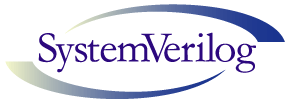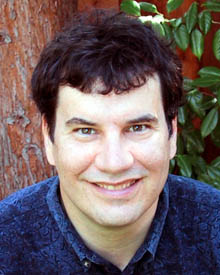Verilog, standardized as IEEE 1364, is a hardware description language (HDL) used to model electronic systems. It is most commonly used in the design and verification of digital circuits at the register-transfer level of abstraction. It is also used in the verification of analog circuits and mixed-signal circuits, as well as in the design of genetic circuits. In 2009, the Verilog standard was merged into the SystemVerilog standard, creating IEEE Standard 1800-2009. Since then, Verilog is officially part of the SystemVerilog language. The current version is IEEE standard 1800-2017.
In computer engineering, a hardware description language (HDL) is a specialized computer language used to describe the structure and behavior of electronic circuits, and most commonly, digital logic circuits.
Electronic design automation (EDA), also referred to as electronic computer-aided design (ECAD), is a category of software tools for designing electronic systems such as integrated circuits and printed circuit boards. The tools work together in a design flow that chip designers use to design and analyze entire semiconductor chips. Since a modern semiconductor chip can have billions of components, EDA tools are essential for their design; this article in particular describes EDA specifically with respect to integrated circuits (ICs).
Synopsys is an American electronic design automation company that focuses on silicon design and verification, silicon intellectual property and software security and quality. Products include logic synthesis, behavioral synthesis, place and route, static timing analysis, formal verification, hardware description language simulators, and transistor-level circuit simulation. The simulators include development and debugging environments that assist in the design of the logic for chips and computer systems. In recent years, Synopsys has expanded its products and services to include application security testing. Their technology is present in self-driving cars, artificial intelligence, and internet of things consumer products.
VLSI Technology, Inc., was an American company that designed and manufactured custom and semi-custom integrated circuits (ICs). The company was based in Silicon Valley, with headquarters at 1109 McKay Drive in San Jose. Along with LSI Logic, VLSI Technology defined the leading edge of the application-specific integrated circuit (ASIC) business, which accelerated the push of powerful embedded systems into affordable products.

SystemVerilog, standardized as IEEE 1800, is a hardware description and hardware verification language used to model, design, simulate, test and implement electronic systems. SystemVerilog is based on Verilog and some extensions, and since 2008 Verilog is now part of the same IEEE standard. It is commonly used in the semiconductor and electronic design industry as an evolution of Verilog.

OrCAD Systems Corporation was a software company that made OrCAD, a proprietary software tool suite used primarily for electronic design automation (EDA). The software is used mainly by electronic design engineers and electronic technicians to create electronic schematics, perform mixed-signal simulation and electronic prints for manufacturing printed circuit boards. OrCAD was taken over by Cadence Design Systems in 1999 and was integrated with Cadence Allegro since 2005.
Phil Moorby is a British engineer and computer scientist. Moorby was born and brought up in Birmingham, England, and studied Mathematics at Southampton University, England. Moorby received his master's degree in computer science from Manchester University, England, in 1974. He moved to the United States in 1983.

Cadence Design Systems, Inc., headquartered in San Jose, California, is an American multinational computational software company, founded in 1988 by the merger of SDA Systems and ECAD, Inc. The company produces software, hardware and silicon structures for designing integrated circuits, systems on chips (SoCs) and printed circuit boards.
Aldec, Inc. is a privately owned electronic design automation company based in Henderson, Nevada that provides software and hardware used in creation and verification of digital designs targeting FPGA and ASIC technologies.
IP-XACT is an XML format that defines and describes individual, re-usable electronic circuit designs to facilitate their use in creating integrated circuits. IP-XACT was created by the SPIRIT Consortium as a standard to enable automated configuration and integration through tools.
MyHDL is a Python-based hardware description language (HDL).
High-level synthesis (HLS), sometimes referred to as C synthesis, electronic system-level (ESL) synthesis, algorithmic synthesis, or behavioral synthesis, is an automated design process that takes an abstract behavioral specification of a digital system and find a register-transfer level structure that realizes the given behavior.

Forte Design Systems, Inc. was a San Jose, CA, based provider of high-level synthesis (HLS) software products, also known as electronic system-level (ESL) synthesis. Forte's main product was Cynthesizer. On February 14, 2014, Forte was acquired by Cadence Design Systems.

Verilator is a free and open-source software tool which converts Verilog to a cycle-accurate behavioral model in C++ or SystemC. It is restricted to modeling the synthesizable subset of Verilog and the generated models are cycle-accurate, 2-state, with synthesis semantics. As a consequence, the models typically offer higher performance than the more widely used event-driven simulators, which can process the entire Verilog language and model behavior within the clock cycle. Verilator is now used within academic research, open source projects and for commercial semiconductor development. It is part of the growing body of free EDA software.
Catapult C Synthesis, a commercial electronic design automation product of Mentor Graphics, is a high-level synthesis tool, sometimes called algorithmic synthesis or ESL synthesis. Catapult C takes ANSI C/C++ and SystemC inputs and generates register transfer level (RTL) code targeted to FPGAs and ASICs.

EVE/ZeBu is a provider of hardware-assisted verification tools for functional verification of Application-specific integrated circuits (ASICs) and system on chip (SOC) designs and for validation of embedded software ahead of implementation in silicon. EVE's hardware acceleration and hardware emulation products work in conjunction with Verilog, SystemVerilog, and VHDL-based simulators from Synopsys, Cadence Design Systems and Mentor Graphics. EVE's flagship product is ZeBu.
IC Manage is a company that provides design data and IP management, Big Data Analytics, Hybrid Cloud Bursting, and High-Performance Computing software to semiconductors, systems, Internet of Things and artificial intelligence IC companies.

Kenneth S. Kundert is an engineer that is notable for his work in the area of Electronic Design Automation (EDA). He studied electrical engineering at the University of California, Berkeley under professors Alberto Sangiovanni-Vincentelli and Robert Meyer and received his doctorate in 1989. During this time, he created the Spectre circuit simulator. He was elevated to the status of IEEE Fellow in 2007 for contributions to simulation and modeling of analog, RF, and mixed-signal circuits.
Prabhu Goel is an Indian American researcher, entrepreneur and businessman, known for having developed the PODEM Automatic test pattern generation and Verilog hardware description language.






